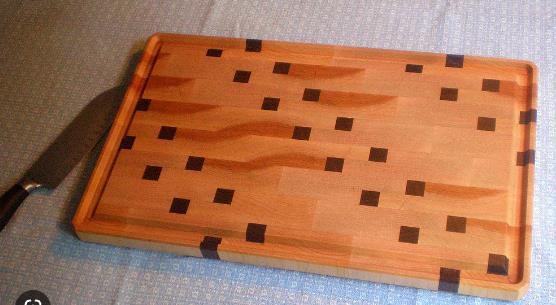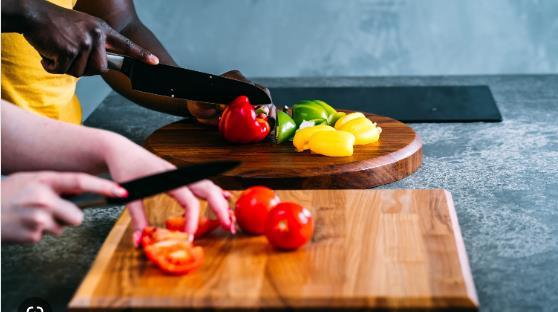Are Walnut Cutting Boards Safe? The Best Guide To Know Truth

Choosing the right cutting board for your kitchen is vital to preparing healthy and safe meals. Walnut cutting boards are becoming increasingly popular due to their durability and attractive design. But are walnut cutting boards safe to use?
Yes, walnut cutting boards are safe for use in the kitchen. Walnut is a dense and durable hardwood that resists scratches and bacteria growth. It is also non-toxic and does not release harmful chemicals. Keeping the board clean and in good shape is essential to ensure it is safe.
In this blog, I’ll explore the pros and cons of using walnut cutting boards and how to get the most out of them. I’ll also look at the safety considerations when using walnut cutting boards and provide some tips for keeping them in good condition.
Definition Of A Walnut Cutting Board
A walnut cutting board is a kitchen item for cutting, slicing, and chopping food. It is made of hardwood material, such as walnut, which is known to be relatively durable and long-lasting.
Walnut cutting boards are often preferred due to their attractiveness, as the rich grain and color of the wood add a decorative touch to the kitchen. They are also known to be safe to use, as the hardwood material is much less likely to accumulate bacteria than other types of cutting board, such as plastic.
Is Walnut Good For Cutting Board?

A cutting board made of walnut is a great choice. It is a hardwood that doesn’t scratch easily and lasts long. It makes it perfect for a cutting board. Walnut is also naturally antibacterial, making it a good choice for a cutting board you want to keep clean.
Walnut also has a beautiful color and grain pattern that can make your kitchen look better. It is also easy to clean and can be protected and kept in good shape with mineral oil that is safe for food.
Are walnut cutting boards safe?
Yes, walnut cutting boards are generally safe to use in the kitchen. Walnut is a complex, dense wood naturally resistant to bacteria and fungi. As long as the board is kept clean and well-maintained, it can be a safe place to cut food. But it’s important to remember that any cutting board can hold bacteria if it isn’t properly cleaned and dried after use.
Benefits of using a walnut cutting board
Using a walnut cutting board has several benefits:
Durability:
Walnut is a hardwood that is known for being strong and lasting. A walnut cutting board can withstand daily use and last for many years.
Knife-friendliness:
Walnut is a fairly soft hardwood that doesn’t hurt knives. Unlike harder woods like maple, walnut doesn’t dull knives as quickly.
Anti-bacterial properties:
Studies have shown that walnut has natural anti-bacterial properties that can stop harmful bacteria from growing on your cutting board.
Aesthetics:
Aesthetically, walnut is a beautiful wood with a rich, dark color and distinct grain patterns. A walnut cutting board can add a touch of elegance to your kitchen and be used as a stylish serving platter for cheese, charcuterie, and other appetizers.
Sustainability:
Walnuts are a renewable resource that can be grown in many places worldwide. Choosing a walnut cutting board can support sustainable forestry practices and have a smaller environmental impact.
Potential risks of using a walnut cutting board
Walnut cutting boards are popular among people looking for a natural, attractive surface to prepare food on. However, some potential risks are associated with walnut cutting boards.
- Some people may be allergic to walnuts, which means they could have a severe allergic reaction if they touch a walnut cutting board.
- If a walnut cutting board isn’t cleaned and cared for properly, it can hold harmful bacteria that can make you sick and throw you up.
- Damage from knives. Walnut cutting boards can sometimes get small grooves and cuts on the surface from knives. These grooves can hold germs and make it harder to clean the board.
- It can warp if you don’t take care of your walnut cutting board properly. It can make the board useless and even dangerous to use.
- Over time, walnut cutting boards can get stains, which can be unsightly and hard to remove.
To reduce these risks, you should keep your walnut cutting board clean and in good shape, avoid using it to cut meat or poultry, and replace it if it gets too damaged or warped.
Alternative cutting board materials
Cutting boards are essential items in the kitchen. Apart from wood, there are several alternatives available for cutting boards. Like:
Plastic cutting board
Plastic cutting boards are popular due to their affordability and easy maintenance. However, their non-porous surface can easily get scratched, allowing bacteria to thrive.
Glass cutting board
Glass cutting boards are also available and offer a smooth, non-porous surface. They can be easily cleaned and are dishwasher safe. However, they are prone to chipping and can be heavier than other materials.
Bamboo cutting board
Bamboo cutting boards are an increasingly popular choice due to their sustainability and lightweight. They have a harder surface than wood and are less prone to knife damage.
Acrylic cutting boards
Acrylic cutting boards are a good option for those who want a lightweight and durable one. They are non-porous and can be easily cleaned.
So, when it comes to choosing a cutting board, there are several materials to choose from. Each
Tips for the safe use of a walnut cutting board

Walnut cutting boards are an excellent choice for your kitchen. They are strong and durable, as well as aesthetically pleasing. However, taking some precautions when using a walnut cutting board is important to ensure food safety. Here are some tips for safely using a walnut cutting board:
- Clean the board after each use. This will help prevent the potential transfer of bacteria from one food item to another.
- Sanitize the board with one tablespoon of bleach per gallon of water.
- Avoid using harsh chemicals or abrasives on the board.
- Oil the board regularly with food-safe mineral oil to prevent drying.
- Do not use the board for raw meat, poultry, or fish.
- Do not soak the board in water for extended periods, which can cause the wood to warp.
Following these tips will help ensure that your walnut cutting board remains.
People Also Ask
- Are walnut cutting boards more durable than other boards?
Yes, walnut cutting boards are more durable than other boards due to their hardness and strength.
2. Is it safe to use a walnut cutting board for meat?
Yes, it is safe to use a walnut cutting board for meat as long as it is properly cleaned and sanitized after use.
3. Is walnut suitable for cutting vegetables?
Yes, walnut is an ideal material for cutting vegetables as it is dense, making it a safe and sturdy surface for food preparation.
4. Are there any potential risks of using a walnut cutting board?
Yes, there are potential risks associated with using a walnut cutting board. Walnut has anti-bacterial properties. However, it is also a porous material and can absorb liquids, which can cause bacteria to form and spread. It is also less durable than other materials, such as plastic, and can chip or crack more easily. Additionally, walnut is softer and more prone to scratches and knife marks.
5. Is it easy to clean a walnut cutting board?
Yes, it is easy to clean a walnut cutting board. It can be cleaned with hot, soapy water and a scrub brush. It should be rinsed and left to air dry. To protect the wood, it is essential to oil the board after every few uses with mineral oil.
6. Does a walnut cutting board require special maintenance?
Yes, walnut cutting boards require special maintenance. After each use, they must be oiled regularly and cleaned with warm water. It is also essential to allow the board to dry completely before using it again.
Final Thought
Walnut cutting boards are an attractive and hygienic addition to any kitchen. When used correctly, they are safe and can last for many years. To ensure safe use, clean your walnut cutting board after each use, and do not cut raw meat and vegetables on the same surface.
Regularly oil the board to maintain its condition. Finally, store the board in a dry place away from direct sunlight and heat. With proper care and maintenance, your walnut cutting board will provide you with years of safe, reliable use.
I hope you enjoy my latest blog, “are walnut cutting boards safe.” If you have any questions, please comment without hesitation.

